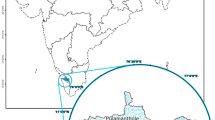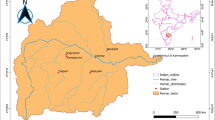Abstract
In this study, a new method was proposed to model the occurrence of related variables based on the conditional density of copula functions. The proposed method was adopted to investigate the dynamics of meteorological and hydrological droughts in the Zarinehroud basin, southeast of Lake Urmia, during the period 1994–2015. For this purpose, the modified precipitation anomaly percentage and streamflow drought indices were extracted. Finally, the joint frequency analysis of duration-duration and severity-severity characteristics of meteorological and hydrological droughts was analyzed. Analysis of 7 different copulas used to create the joint distribution in the Zarinehroud basin indicated that the Frank copula had the best performance in describing the relationship between the meteorological and hydrological drought severities and durations. By examining the results of the bivariate analysis of duration-duration of meteorological and hydrological droughts at different stations, the expected meteorological and hydrological drought durations were estimated in the years ahead. For example, at Chalkhmaz station, 4- to 7-month duration for the hydrological drought and 9- to 12-month duration for the meteorological drought is expected in the years ahead. The joint frequency analysis of drought characteristics allows to determine the meteorological and hydrological drought characteristics at a single station at the same time using joint probabilities. Also, the results indicated that by knowing the conditional density, the hydrological drought characteristics can be easily estimated for the given meteorological drought characteristics. This could provide users and researchers useful information about the probabilistic behavior of drought characteristics for optimal operation of surface water.







Similar content being viewed by others
References
Abdi A, Hassanzadeh Y, Talatahari S, Fakheri-Fard A, Mirabbasi R (2017) Regional bivariate modeling of droughts using L-comoments and copulas. Stoch Env Res Risk A 31(5):1199–1210
Ahmadi F, Nazeri Tahroudi M, Mirabbasi R, Khalili K, Jhajharia D (2018) Spatiotemporal trend and abrupt change analysis of temperature in Iran. Meteorol Appl 25(2):314–321. https://doi.org/10.1002/met.1694
Ahmadi F, Radmaneh F, Parham GA, Mirabbasi R (2017) Comparison of the performance of power law and probability distributions in the frequency analysis of flood in Dez Basin, Iran. Nat Hazards 87(3):1313–1331
Ben-Zvi A (1987) Indices of hydrological drought in Israel. J Hydrol 92(1–2):179–191
Chen L, Singh VP, Shenglian G, Hao Z, Li T (2011) Flood coincidence risk analysis using multivariate copula functions. J Hydrol Eng 17(6):742–755
De Michele C, Salvadori G (2003) A generalized Pareto intensity-duration model of storm rainfall exploiting 2-copulas. Journal of Geophysical Research: Atmospheres 108:1–15
De Michele C, Salvadori G, Canossi M, Petaccia A, Rosso R (2005) Bivariate statistical approach to check adequacy of dam spillway. J Hydrol Eng 10(1):50–57
Genest C, Favre AC, Béliveau J, Jacques C (2007) Metaelliptical copulas and their use in frequency analysis of multivariate hydrological data. Water Resour Res 43(9):1–12
Jaworski P, Durante F, Hardle WK, Rychlik T (2010) Copula theory and its applications, vol 198. Springer, New York
Joe H (1997) Multivariate models and multivariate dependence concepts. CRC Press
Kao SC, Govindaraju RS (2010) A copula-based joint deficit index for droughts. J Hydrol 380(1–2):121–134
Khozeymehnezhad H, Nazeri-Tahroudi M (2020) Analyzing the frequency of non-stationary hydrological series based on a modified reservoir index. Arab J Geosci 13(5):1–13
Mirabbasi R, Anagnostou EN, Fakheri-Fard A, Dinpashoh Y, Eslamian S (2013) Analysis of meteorological drought in Northwest Iran using the joint deficit index. J Hydrol 492:35–48
Mirabbasi R, Fakheri-Fard A, Dinpashoh Y (2012) Bivariate drought frequency analysis using the copula method. Theor Appl Climatol 108(1–2):191–206
Mogheir Y, Singh VP (2003) Specification of information needs for groundwater management planning in developing country. Groundwater Hydrology Balema Publisher Tokyo 2:3–20
Nalbantis I, Tsakiris G (2009) Assessment of hydrological drought revisited. Water Resour Manag 23(5):881–897
Nash JE, Sutcliffe JV (1970) River flow forecasting through conceptual models part I—A discussion of principles. J Hydrol 10(3):282–290
Nelsen RB (2006) An introduction to copulas. Springer, New York
Ramezani Y, Tahroudi MN, Ahmadi F (2019) Analyzing the droughts in Iran and its eastern neighboring countries using copula functions. Quarterly Journal of the Hungarian Meteorological Service 123(4):435–453
Reddy M, Ganguli P (2012) Application of copulas for derivation of drought severity–duration–frequency curves. Hydrol Process 26(11):1672–1685
Salvadori G, De Michele C (2007) On the use of copulas in hydrology: theory and practice. J Hydrol Eng 12(4):369–380
Salvadori G, De Michele C, Kottegoda NT, Rosso R (2007) Extremes in nature: an approach using copulas (Vol. 56) Springer Science & Business Media
Shafaei M, Fakheri-Fard A, Dinpashoh Y, Mirabbasi R, De Michele C (2017) Modeling flood event characteristics using D-vine structures. Theor Appl Climatol 130(3–4):713–724
Shiau JT, Modarres R (2009) Copula-based drought severity-duration-frequency analysis in Iran. Meteorological Applications: A journal of forecasting, practical applications, training techniques and modelling 16(4):481–489
Shiau JT, Shen HW (2001) Recurrence analysis of hydrologic droughts of differing severity. J Water Resour Plan Manag 127(1):30–40
Sklar M (1959) Functions de repartition an dimensions et leurs marges. Publ inst statist univ Paris 8:229–231
Tahroudi MN, Khalili K, Ahmadi F, Mirabbasi R, Jhajharia D (2019b) Development and application of a new index for analyzing temperature concentration for Iran’s climate. Int J Environ Sci Technol 16(6):2693–2706
Tahroudi MN, Siuki AK, Ramezani Y (2019a) Redesigning and monitoring groundwater quality and quantity networks by using the entropy theory. Environ Monit Assess 191(4):250
Tahroudi MN, Ramezani Y, De Michele C, Mirabbasi R (2020) Analyzing the conditional behavior of rainfall deficiency and groundwater level deficiency signatures by using copula functions. Hydrol Res. https://doi.org/10.2166/nh.2020.036
Yang A, Si Y, Fan Y, Kong X, Lin X (2019) Correlation study of rainfall and runoff in Xiangxi River based on Archimedean copula function. In IOP conference series: earth and environmental science (Vol. 223, no. 1, p. 012055) IOP publishing
Zamani R, Mirabbasi R, Nazeri M, Meshram SG, Ahmadi F (2018) Spatio-temporal analysis of daily, seasonal and annual precipitation concentration in Jharkhand state, India. Stoch Env Res Risk A 32(4):1085–1097
Zhang DD, Yan DH, Lu F, Wang YC, Feng J (2015) Copula-based risk assessment of drought in Yunnan province, China. Nat Hazards 75(3):2199–2220
Zhang Q, Li J, Singh VP, Xu CY (2013) Copula-based spatio-temporal patterns of precipitation extremes in China. Int J Climatol 33(5):1140–1152
Acknowledgments
The authors would like to thank Politecnico di Milano for providing the facilities to the first author as a visiting researcher. Also, the authors would like to thank Iran Water Resources Management Company for providing the data.
Funding
This research did not receive any specific grant from funding agencies in the public, commercial, or not-for-profit sectors.
Author information
Authors and Affiliations
Corresponding author
Ethics declarations
Conflict of Interest
None.
Additional information
Publisher’s Note
Springer Nature remains neutral with regard to jurisdictional claims in published maps and institutional affiliations.
Rights and permissions
About this article
Cite this article
Nazeri Tahroudi, M., Ramezani, Y., De Michele, C. et al. A New Method for Joint Frequency Analysis of Modified Precipitation Anomaly Percentage and Streamflow Drought Index Based on the Conditional Density of Copula Functions. Water Resour Manage 34, 4217–4231 (2020). https://doi.org/10.1007/s11269-020-02666-6
Received:
Accepted:
Published:
Issue Date:
DOI: https://doi.org/10.1007/s11269-020-02666-6




